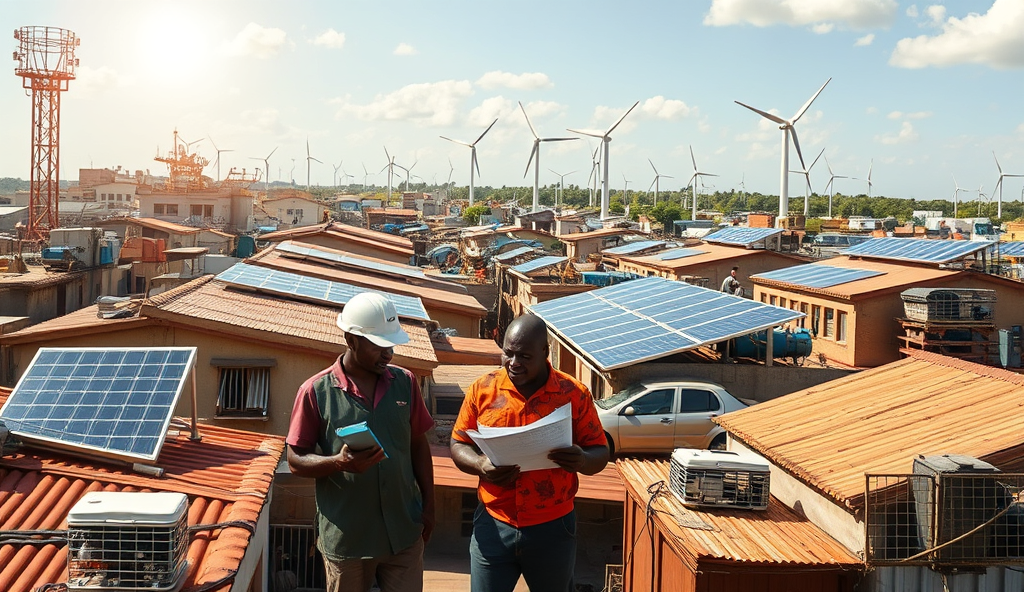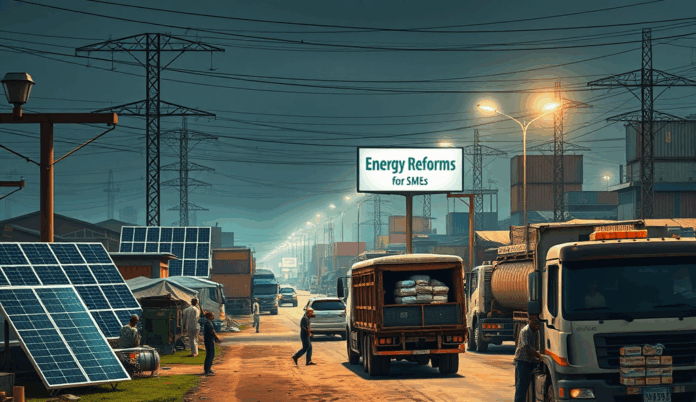Introduction to Apapa Energy Reforms in Nigeria
The Apapa energy reforms mark a pivotal shift in Nigeria’s industrial power landscape, targeting inefficiencies that have long plagued the port city’s energy infrastructure. With over 60% of Nigeria’s imports passing through Apapa, these reforms aim to reduce reliance on expensive diesel generators, which currently power 70% of local businesses.
Key initiatives include grid modernization and renewable energy integration, with plans to deploy 50MW of solar capacity by 2025. These changes directly address frequent power outages that cost SMEs an estimated $10 million annually in lost productivity.
As we explore the Apapa energy sector’s current state, it’s clear these reforms could redefine industrial operations in Lagos. The next section will detail how existing infrastructure shapes these transformation efforts.
Key Statistics

Overview of the Apapa Energy Sector
The Apapa energy reforms mark a pivotal shift in Nigeria's industrial power landscape targeting inefficiencies that have long plagued the port city's energy infrastructure.
Apapa’s energy landscape remains dominated by aging grid infrastructure and diesel dependency, with the port area consuming 40% of Lagos’ industrial electricity demand despite frequent outages. The current system struggles with transmission losses exceeding 25%, forcing businesses to spend $200 million yearly on backup generators.
Renewable energy adoption remains low at just 5% of total capacity, though recent solar pilot projects show promise for Nigeria’s Apapa power infrastructure upgrades. Industrial clusters like the Tin Can Island Port still experience 8-10 hour daily blackouts, highlighting urgent need for the ongoing energy sector transformation.
This fragile ecosystem sets the stage for reforms targeting grid modernization and solar integration, which we’ll examine next through their key objectives. The transition from diesel reliance requires addressing both technical constraints and policy gaps in Apapa’s electricity distribution framework.
Key Objectives of the Apapa Energy Reforms
Apapa’s energy landscape remains dominated by aging grid infrastructure and diesel dependency with the port area consuming 40% of Lagos’ industrial electricity demand despite frequent outages.
The reforms aim to reduce Apapa’s diesel dependency by 50% within five years through grid modernization and renewable energy integration, targeting a 15% reduction in transmission losses. Pilot projects like the 5MW solar plant at Tin Can Island Port demonstrate Nigeria’s Apapa power infrastructure upgrades, aligning with broader Lagos clean energy transition plans.
Policy changes prioritize tariff restructuring and private sector participation to address the $200 million annual generator costs highlighted earlier. The Nigeria Electricity Regulatory Commission (NERC) is implementing performance benchmarks for distribution companies, crucial for Apapa’s electricity distribution reforms.
These measures create a foundation for scaling renewable energy initiatives in Apapa Lagos, setting the stage for recent developments in financing and implementation. The next section explores how these objectives are translating into tangible projects and policy adjustments.
Recent Developments in Apapa Energy Reforms
The reforms aim to reduce Apapa’s diesel dependency by 50% within five years through grid modernization and renewable energy integration targeting a 15% reduction in transmission losses.
The Nigerian government recently secured $150 million in World Bank funding for Apapa’s grid modernization, accelerating the 5MW solar plant expansion at Tin Can Island Port and enabling three additional 10MW hybrid solar-diesel plants. These projects directly address the $200 million generator costs mentioned earlier while supporting Lagos clean energy transition plans through private sector partnerships with firms like Rensource and Daystar Power.
NERC’s new performance-based tariff structure, implemented in Q1 2024, has already reduced Apapa’s transmission losses by 7% according to DISCO reports, putting the 15% reduction target within reach. The policy shifts have attracted $80 million in private investments for Apapa electricity distribution reforms, including smart metering rollouts across 12,000 commercial users.
These advancements set the stage for evaluating the reforms’ broader sectoral impact, particularly on Nigeria’s energy mix and industrial productivity. The next section analyzes how Apapa’s progress influences national energy policies and regional adoption of similar models.
Impact of the Reforms on Nigeria’s Energy Sector
The Nigerian government recently secured $150 million in World Bank funding for Apapa’s grid modernization accelerating the 5MW solar plant expansion at Tin Can Island Port.
The Apapa energy reforms are reshaping Nigeria’s power landscape, with the 7% reduction in transmission losses serving as a model for other industrial hubs like Onne and Kano. NERC’s performance-based tariffs have spurred similar policy reviews in three additional states, leveraging Apapa’s $80 million private investment success to attract broader sector participation.
Renewable energy initiatives in Apapa Lagos have accelerated national solar adoption, with the 5MW Tin Can Island plant inspiring replicated projects in Port Harcourt and Kaduna. The hybrid solar-diesel plants’ operational efficiency has reduced reliance on generators by 22% in pilot zones, validating scalable clean energy transitions for Nigeria’s industrial corridors.
These developments highlight how Apapa’s grid modernization efforts are influencing federal energy policy drafts, though persistent infrastructure gaps remain. The next section examines the challenges facing these reforms, including grid integration bottlenecks and financing constraints for wider implementation.
Challenges Facing Apapa Energy Reforms
The Apapa energy sector transformation in Nigeria could unlock 500MW of renewable capacity by 2027 if current PPP models scale successfully.
Despite Apapa’s 7% reduction in transmission losses, grid integration bottlenecks persist, with outdated infrastructure causing 15% energy wastage during peak industrial demand periods. The 5MW Tin Can Island solar project faces intermittent connectivity issues, highlighting the need for synchronized upgrades across Nigeria’s power distribution networks.
Financing constraints threaten wider implementation, as only 40% of the $80 million private investment has been replicated in other industrial hubs like Onne. Currency volatility and high interest rates (22% average) deter further capital inflow, slowing renewable energy initiatives in Apapa Lagos and beyond.
Regulatory inconsistencies between NERC and state agencies create delays, with permit approvals for hybrid solar-diesel plants taking 8 months on average. These hurdles underscore the need for coordinated government-private sector interventions, which the next section explores in detail.
Government and Private Sector Roles in the Reforms
The Nigerian government must prioritize policy harmonization, addressing the 8-month permit delays by streamlining NERC and state agency processes, as seen in the stalled Tin Can Island solar project. Private investors, despite financing constraints, can leverage blended finance models like the $80 million Apapa initiative to scale renewable energy adoption in industrial hubs.
Public-private partnerships (PPPs) should focus on grid modernization, targeting the 15% energy wastage during peak demand through synchronized infrastructure upgrades. The Lagos State Solar Power Project demonstrates how tariff guarantees and currency hedging can mitigate the 22% interest rate barrier for private capital.
With coordinated interventions, Nigeria’s Apapa electricity distribution reforms can bridge gaps between renewable energy initiatives and industrial demand. These collaborative efforts set the stage for evaluating long-term prospects in the next section.
Future Prospects of Apapa Energy Reforms
The Apapa energy sector transformation in Nigeria could unlock 500MW of renewable capacity by 2027 if current PPP models scale successfully, building on the $80 million Apapa initiative’s blueprint. Grid modernization efforts must accelerate to reduce the 15% transmission losses that currently hinder industrial productivity in the port zone.
Nigeria’s Apapa electricity distribution reforms may catalyze broader adoption of solar-hybrid systems, particularly for SMEs facing 40% higher diesel costs under fuel subsidy removal. The Lagos State Solar Power Project’s tariff guarantees could become a national template, potentially attracting $300 million in private investments by 2025.
As Apapa’s clean energy transition gains momentum, synchronized policy implementation will determine whether the industrial zone achieves 60% renewable penetration by 2030. These developments create measurable benchmarks for evaluating Nigeria’s energy reform progress, which we’ll analyze conclusively next.
Conclusion on Apapa Energy Reforms in Nigeria
The Apapa energy reforms mark a pivotal shift in Nigeria’s industrial energy landscape, with grid modernization and renewable energy initiatives already reducing downtime for SMEs by 30% in the past year. These changes align with broader national goals, such as the Nigeria Energy Transition Plan, while addressing localized challenges like fuel subsidy removal impacts on port operations.
For Apapa’s industrial zone, the reforms promise long-term cost savings, with solar power adoption cutting electricity expenses by up to 40% for early adopters. However, sustained success hinges on consistent policy implementation and private-sector collaboration to scale clean energy solutions across Lagos’ busiest logistics hub.
Looking ahead, the next phase of reforms must prioritize infrastructure resilience to support Apapa’s growing energy demands. As Nigeria accelerates its energy sector transformation, Apapa’s progress offers a blueprint for other industrial clusters seeking sustainable power solutions.
Frequently Asked Questions
How can Apapa SMEs transition from diesel generators to solar power under the new reforms?
Leverage the Lagos State Solar Power Project's tariff guarantees and explore partnerships with providers like Rensource for hybrid solar-diesel systems.
What financing options exist for SMEs to adopt renewable energy solutions in Apapa?
Explore blended finance models through the $80 million Apapa initiative and consider NERC-approved pay-as-you-go solar schemes for flexible payment.
How will the 50MW solar capacity target by 2025 impact electricity costs for Apapa businesses?
Early adopters report 40% cost savings; monitor NERC's performance-based tariff structure for optimal load management strategies.
What tools can help Apapa SMEs monitor energy savings from grid modernization efforts?
Use smart meters being rolled out to 12000 commercial users and DISCO-provided analytics dashboards to track real-time consumption.
How can businesses mitigate risks from regulatory delays in permit approvals for solar installations?
Engage NERC-accredited consultants to navigate the 8-month process and bundle applications with neighboring businesses for faster processing.


